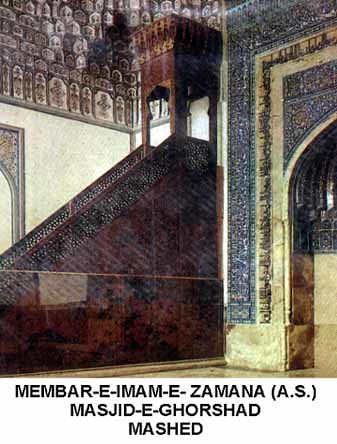Grave of Hazrat Khadija
Dr. Mazhar Naqvi
The tenth day of Ramadan
(Ramzan) is a just a couple of days away. Like other days of the month, this
day will also pass with Muslims observing fast from dawn to dusk and engrossed
in prayers. But very few would remember that it was on this day Hazrat Khadija,
the wife of Prophet Hazrat Muhammad, had breathed her last in 619 AD and her
death had left the holy Prophet in a state of much bereavement. This is surely
not an ideal situation. In an era when fanatics in Syria, Pakistan, Yemen,
Afghanistan, Iraq and several other pockets of the world are bent upon to
relegate the position of women to the period of ‘Jahiliyah’ (Ignorance), it is incumbent upon all the true believers
to create awareness about the life and works of Hazrat Khadija. There is also
an urgent need to draw inspiration and lessons from her life to inculcate the
culture of professionalism and entrepreneurship among Muslim
women.
Hazrat Khadija was born in Mecca in 555 CE to
Khuwalid bin Asad in a noble and pious family. Her mother’s name was
Fatima Binte Zaaeda. As her parents were honest
and pious, Hazrat Khadija grew up to be one of the most enlightened women in
the era known as ‘Age of Ignorance’- period when Arab society was at its worst.
At the time of the pagan regime of the Arabs before Islam, she
earned the title of "Tahira" (Pure and Chaste Woman) in her youth
from Arabs only.
She
established herself as a great and distinguished wealthy lady in the Arabian Peninsula
by carrying out business by the assistance of others, who traded in partnership
on her behalf. She came to known about Hazrat
Muhammad when she started looking for an able and honest person who could take
care of her business interests. She was informed about him as the most
trustworthy and honest man on whom she could rely completely. Holy Prophet was
only 25-years-old when she made a proposal to him through his uncle Janab-E-Abu
Talib to manage her business. Impressed with the excellent management of her
business with integrity by Hazrat Muhammad, she proposed and married the Holy
Prophet at the age of 40 in 595 CE. The lower-class and ignorant women of Mecca
who knew Khadija's wealth and prominent
suitors for marriage, criticized her harshly for accepting and marrying the
prophet, who was an orphan of Abdullah, indigent of Bani Hashim and who was not
of her standing. But she remained firm in her decision and ignored such
criticism. Khadija lived with the prophet for 25 years and was his only wife
during that period. When the revelations came from Allah and Muhammad was made
and declared the last prophet in 610 CE, it was Khadija who accepted the faith
and became the first Muslim. She was 55 years old at that time. Her acceptance
of Islam greatly helped the spread of the religion among the Mecca residents.
Her life exemplifies that Islam in no
way discourages women to do a job when needed. She was also very professional
in her work dealt with everyone in a modest manner. She never mixed
professionalism with arrogance. She exhibited how to be a professional and soft
hearted at the same time. Another thing very good about her was that she used to
appreciate her workers and in turn they used to work better. Is it not an
example of non-monetary incentives that are described as essential for successful
human resource management in the present era? Hazrat Khadija showed to the
world that success in business depends upon understanding of human nature and acknowledgement
of people’s sincere effort for achieving the pre-determined objectives of the enterprise.
She
was an amazingly brave woman who had faith in Allah no matter what
circumstances she faced. She stood by the prophet all the time. In
moments of trial and difficulty, the prophet used to come to her and she
consoled and comforted her husband and encouraged him. She spent all her wealth
in propagation of Islam. She was his friend, advisor and
consoler. Right after the Revelation, the Holy Prophet (S.A.W) came to her
quite distressed and narrated her what had taken place. Hazrat Khadija (R.A)
believed his every word, smiled the most beautiful smile, and comforted him by
saying “I feel you are becoming a Prophet.” Even after Prophet Hood, she bore
the hardships of Shaibe Abi Talib with
great patience and endurance even though she was more of age than Hazrat
Muhammad. She also gave her daughter like Bibi Fatima Zahra who is a role model
for women of all times. Because of her these virtues, the Prophet had remarked “Khadija
married when none believed me. She made me a partner in her wealth." He
also said that she was one of the four perfect women who had ever lived. The
other three being Janab-E-Asiya, the wife of Firaun, Hazrat Maryam, the mother
of Prophet Isa and Hazrat Fatima Zahra, daughter of Prophet Muhammad, wife of
Hazrat Ali and mother of Hasnain i.e. Imam Hasan and Hussain.(Reference
available on request)


